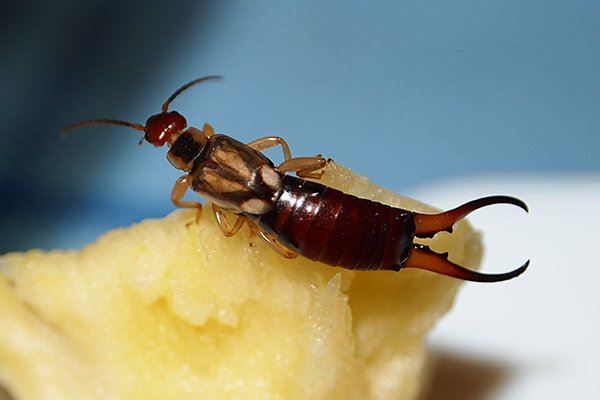
What Every Sacramento Resident Ought To Know About Earwigs
Have you ever flipped a rock or piece of wood over and watched a creepy, reddish-brown bug with big black pincers scurry away and disappear under something else? That was an earwig. Today, we're talking a little bit about what these insects are and what it means when you find them inside your Sacramento home.

5 Things You Should Know About Earwigs
- An earwig is an insect. As an insect, it has six legs, three body parts, two antennae, and a hard exoskeleton. The most common earwig in our service area is the European earwig, which is known scientifically as Forficula auricularia.
- European earwigs don't bite or sting, and are not known to spread diseases. They can, however, deliver a little pinch. But this pinch is not strong enough to break the skin.
- While earwigs can crawl into your ear, like many insects, they aren't going to lay their eggs in your ear or tunnel into your brain. Those are myths.
- Earwigs can be beneficial insects because they eat aphids and other plant-damaging insects. But they're ability to destroy seedling vegetables, fruits, berries, and annual flowers makes them an unwanted addition to your landscaping. Another species, the striped earwig, known scientifically as Labidura riparia, does not damage plants.
- These insects create an unpleasant odor when squashed.
What It Means When You Find Earwigs Inside
- It means you have entry points. These insects don't chew their way into your home. They use cracks, gaps, and openings created by wood-damaging pests or openings that develop in rotted wood.
- It means you may have wood rot. Earwigs have a strong attraction to moist wood, and they usually enter a home through spots that have been damaged by water.
- It means conditions outside are unfavorable. If there is a period of drought, heavy rains, extended heat, or a cold snap, it can drive these insects inside.
- It means you have exterior ground lighting. Earwigs are attracted to light. While lights are great for security, they have a downside. Earwigs, and many other insects, are drawn to light sources.
- It means you probably have moist or humid locations within your home. These insects don't want to be inside a home that is dry.
How Do You Get Rid Of Earwigs?
Reduce moisture:
Clear gutters of obstructions. Water plants in the morning. Trim tree branches to allow sunlight into shaded areas. Put spacing between plants to increase airflow.
Remove clutter:
These insects hide under piles of rubbish, leaves, woodpiles, and objects in your yard.
Remove dense vegetation:
Tall grass, ivy, weeds, and other dense vegetation will provide the moisture and shade these insects thrive in. There is also likely to be a large population of insects for earwigs to feed on in overgrown areas.
Seal entry points:
Do a detailed inspection of your foundation walls and exterior. Seal any potential entry points these insects can use to get in. If you have areas of wood rot, they should be addressed. Wood rot isn't just attractive to earwigs, it will lure termites, carpenter ants, mice, rats, and other wood-damaging pests.
Apply traps:
After you alter conditions that promote earwig activity, you can go one step further and place traps out to capture earwigs. Use tuna fish cans with ½ an inch of oil in the bottoms. Fish oil, vegetable oil with a few drops of bacon grease will work nicely. Once the earwigs crawl inside, they can't crawl back up the smooth, slippery metal to get back out. For the best results, put the cans into the ground with the top level with the surface of the ground. Monitor and remove the cans as necessary.
The Best Control
If you want to get control of earwigs, why not get control of all the pests around your home? At Pro Active Pest Control, earwig control comes bundled in our residential pest control service. Choose a plan that works best for your specific pest control needs and budget. Reach out to us today for details. We look forward to helping you get control of earwigs and other pests around and inside your Sacramento home, with ongoing, proactive pest control service you can trust.

WHY CHOOSE OUR TEAM?
Where Value Meets Effectiveness in Pest Control
We strive to exceed expectations through transparent communication, personalized service, and a dedication to ongoing education and innovation in the field of pest management.
-
100% Service Guarantee
At Pro Active, our service plans are covered by a 100% service guarantee. If covered pests return in-between our regularly scheduled treatments – so will we, and at no cost to you!
-
Pet-Friendly
At Pro Active Pest Control, we have the experience and know-how to effectively take care of your most pressing pest issues without endangering your pets, family or environment.
-
Green Pest Services
Through the use of Integrated Pest Management (IPM) techniques, our state-certified specialists provide treatment and prevention services for your home year-round.
-
WE'RE LOCAL
Because we work and live here, we understand the pest pressures that affect our communities. We ensure we effectively solve your pest problems with affordable pest control services.

WE LOVE OUR CUSTOMERS & THEY LOVE US TOO!
Discover What Others Are Saying About Our Services
At Pro Active Pest Control, your satisfaction is our priority! See for yourself what our customers have to say about working with us.
-
"We will never use anyone else!"Tom always checks to make sure we aren’t having any issues and even came back a few times to take care of an issue we had with wasps this summer. We haven’t seen one since! Recommend them to everyone!- Jonathan W.

-
"I love Proactive Pest control."My tech Isidro is always on time, friendly, knowledgeable and makes sure the pests stay away. The service I have is bi-monthly, and ever since Isidro started coming out the preventative work really makes a difference!- Stephanie T.

-
"Love our experience we've had with Pro Active Pest Control!"We don't have any pest issues since having them service us! And absolutely love that we've consistently had the same person come out to do the job! Tom communicates with me every time he comes out so it's appreciated!- Linda P.

-
"Top notch company and service."I’ve had Tom from Pro Active Pest Control doing our monthly pest service. Tom is very professional, calls ahead to let me know he is on his way so I can put our dogs up and always does a thorough job at our house, guest house and barn.- Chris H.

-
"There’s no other company I would use over this one!"Tom with Pro Active Pest Control has been great! Excellent communication and very thorough, friendly, knowledgeable, and professional. Everyone I’ve spoken to on the phone has been the same.- Emily T.

-
"King of Control!"Jason, our King of Control is by far the best Pest Control Tech I've had in the 35 years I've lived in my home. Throughly effective and always a cheery service provider.- Dani B.




